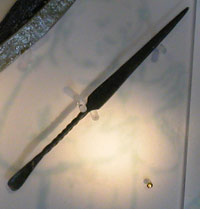 |
 |
 |
 |
 |
 |
 |
|
|
The infirmarer The infirmarer (or server of the sick) was the monastic official (obedientiary) in charge of the abbey’s infirmary, where he oversaw the care of the sick and those recuperating after bloodletting, as well as any elderly members of the community, who were unable to observe the full rigours of the monastic life. The infirmarer’s office was an important and prestigious post. The infirmarer of the abbey at first slept in the common dormitory with the rest of the community, but later on he may have had his own house within or near to the infirmary complex. In the thirteenth century the infirmarer at Roche seemingly had his own lodgings beside the abbot’s house.(1) The infirmarer acted first and foremost as an intermediary between the infirmary and the cloister. Whenever a monk was received in the infirmary it was the infirmarer’s responsibility to transfer his utensils from the refectory and his bedding from the dormitory - which he then replaced when the monk returned to choir – and to fetch the sick monk’s allowance of food and drink from the cellarer each day. The infirmarer borrowed books required for services in the infirmary chapel from the abbey church and ensured that these, and any other books, were returned safely. He notified the infirm of any matters of importance that had been raised at the daily chapter meeting, and alerted the community of an inmate who was about to die, so that the brethren could make appropriate provision for his soul.
Whenever one of the inmates of the infirmary was ready to rejoin the community, the infirmarer sought authorisation from the abbot for his return to the cloister. The infirmarer was responsible for the overall management of the infirmary complex. He alone was allowed to speak to the inmates, but was to do so quietly and in designated areas. This was not to be an excuse for gossip! His duties within the infirmary included making sure that the fire was lit, lighting the candles for Matins, cleaning the bowls that had been used at bloodletting and disposing of the blood. On Saturdays he washed the feet of those who resided in the infirmary – if they so wished – and shook their clothing.
Chapter 116 of the twelfth-century customary of the Order (Ecclesiastica Officia) discusses the infirmarer’s managerial duties in some detail, but says little of his medical knowledge. However, it is likely that he – and no doubt others in the community – was well-versed in herbal remedies and administered herbs grown at the abbey. The infirmarer may well have had access to medical works. Surviving manuscripts and library catalogues suggest that the Cistercians in England owned works by ancient and contemporary medical authorities, as well as more traditional works such as herbals. For example, a thirteenth-century manuscript from Kirkstall Abbey contains a copy of the Medulla Philosophorum, a miscellany of tracts that includes explanations of various herbs and plants, as well as passages on indigestion, digestion and blood.(2) |
